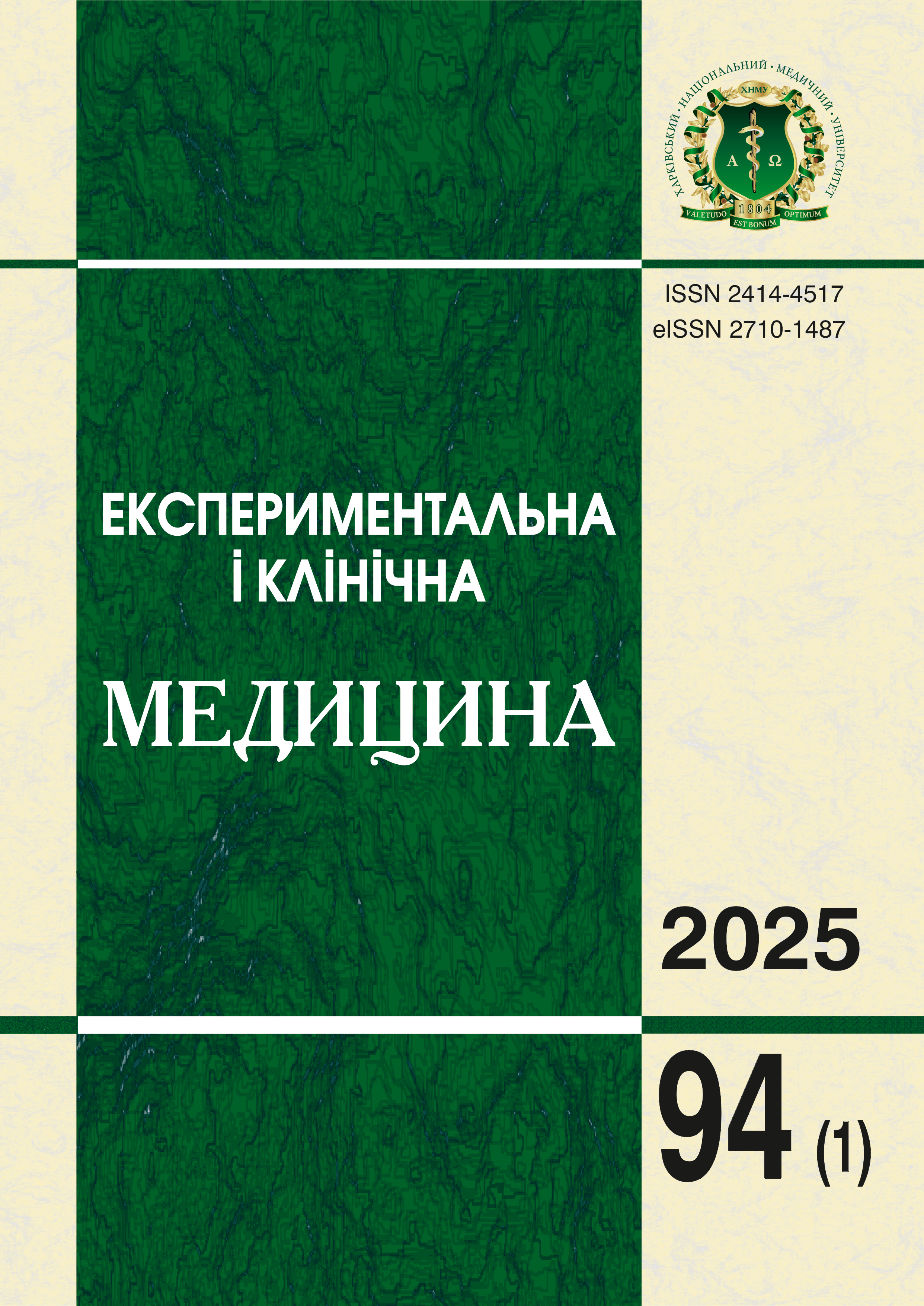Abstract
Arterial Hypertension (AH) is one of the leading causes of morbidity and mortality and is an urgent problem for more than 1.4 billion people worldwide. High mortality risks due to hypertension are associated with the risk of developing dangerous arrhythmias. These conditions can be diagnosed by changes in the QTc interval, which indicates an abnormal repolarization. The aim of the study was to determine the predictors of prolongation of the mean daily QTc interval in hypertension. We examined 195 patients (166 patients with hypertension and 29 patients without hypertension) who were treated at the (Kharkiv) City Polyclinic No.24. All patients were divided into 2 subgroups depending on the duration of the average daily QTc interval: 146 patients with normal QTc and 20 patients with prolonged QTc interval. Associations were determined using logistic regression with Wald's simultaneous inclusion and backward exclusion methods. The results showed that male gender was significantly associated with QTc prolongation (Odds Ratio (OR)=4.292 [95.0% confidence intervals (CI) 1.337–13.779], p=0.014), as did body mass index (BMI) (OR=1.107 [95.0% CI 0.987–1.243], p=0.083) and mean daily Diastolic and Pulse Blood Pressure (DBP and PBP), respectively, OR=1.076 [95.0% CI 1.017–1.139], p=0.011 and OR=1.075 [95.0% CI 1.012–1.141], p=0.018. The time since the diagnosis of hypertension (OR=1.093 [95.0% CI 0.997–1.197], p=0.057) and the office DBP (OR=0.948 [95.0% CI 0.900–0.999], p=0.046) were significantly associated with QTc prolongation. Taking into account the significant associations of male gender, BMI, mean daily DBP and SBP, time from diagnosis of hypertension, and office DBP with the risk of QTc prolongation, a prognostic model for determining the risk of QTc prolongation was developed, which has good qualification characteristics (sensitivity was 88.9% and specificity – 70.6%).
Keywords: associations, medical and epidemiological indicators, electrocardiography, Holter monitoring, linear equation.
Archived: https://doi.org/10.5281/zenodo.16779229
References
Bird K, Chan G, Lu H, Greeff H, Allen J, Abbott D, et al. Assessment of Hypertension Using Clinical Electrocardiogram Features: A First-Ever Review. Front Med (Lausanne). 2020;7:583331. DOI: 10.3389/fmed.2020.583331. PMID: 33344473.
Mills KT, Stefanescu A, He J. The global epidemiology of hypertension. Nat Rev Nephrol. 2020;16(4):223-37. DOI: 10.1038/s41581-019-0244-2. PMID: 32024986.
Tsao CW, Aday AW, Almarzooq ZI, Alonso A, Beaton AZ, Bittencourt MS, et al. Heart Disease and Stroke Statistics-2022 Update: A Report From the American Heart Association. Circulation. 2022;145(8):e153-639. DOI: 10.1161/CIR.0000000000001052. PMID: 35078371.
Mancia G, Kreutz R, Brunström M, Burnier M, Grassi G, Januszewicz A, et al. 2023 ESH Guidelines for the management of arterial hypertension The Task Force for the management of arterial hypertension of the European Society of Hypertension: Endorsed by the International Society of Hypertension (ISH) and the European Renal Association (ERA). J Hypertens. 2023;41(12):1874-2071. DOI: 10.1097/HJH.0000000000003480. PMID: 37345492.
NCD Risk Factor Collaboration (NCD-RisC). Worldwide trends in hypertension prevalence and progress in treatment and control from 1990 to 2019: a pooled analysis of 1201 population-representative studies with 104 million participants. Lancet. 2021;398(10304):957-80. DOI: 10.1016/S0140-6736(21)01330-1. PMID: 34450083.
Ji H, Kim A, Ebinger JE, Niiranen TJ, Claggett BL, Bairey Merz CN, Cheng S. Sex Differences in Blood Pressure Trajectories Over the Life Course. JAMA Cardiol. 2020;5(3):19-26. DOI: 10.1001/jamacardio.2019.5306. PMID: 31940010.
Benetos A, Petrovic M, Strandberg T. Hypertension Management in Older and Frail Older Patients. Circ Res. 2019;124(7):1045-60. DOI: 10.1161/CIRCRESAHA.118.313236. PMID: 30920928.
Van den Hoogen PC, Feskens EJ, Nagelkerke NJ, Menotti A, Nissinen A, Kromhout D. The relation between blood pressure and mortality due to coronary heart disease among men in different parts of the world. Seven countries study research group. N Engl J Med. 2000;342:1-8. DOI: 10.1056/NEJM200001063420101. PMID: 10620642.
Zhou B, Perel P, Mensah GA, Ezzati M. Global epidemiology, health burden and effective interventions for elevated blood pressure and hypertension. Nat Rev Cardiol. 2021;18(11):785-802. DOI: 10.1038/s41569-021-00559-8. PMID: 34050340.
Lu S, Bao MY, Miao SM, Zhang X, Jia QQ, Jing SQ, et al. Prevalence of hypertension, diabetes, and dyslipidemia, and their additive effects on myocardial infarction and stroke: a cross-sectional study in Nanjing, China. Ann Transl Med. 2019;7(18):436. DOI: 10.21037/atm.2019.09.04. PMID: 31700872.
Stergiou GS, Palatini P, Parati G, O’Brien E, Januszewicz A, Lurbe E, et al. 2021 European society of hypertension practice guidelines for office and out-of-office blood pressure measurement. J Hypertens. 2021;39:1293-302. DOI: 10.1097/HJH.0000000000002843. PMID: 33710173.
Burnier M, Damianaki A. Hypertension as Cardiovascular Risk Factor in Chronic Kidney Disease. Circ Res. 2023;132(8):1050-63. DOI: 10.1161/CIRCRESAHA.122.321762. PMID: 37053276.
Solanki JD, Gadhavi BP, Makwana AH, Mehta HB, Shah CJ, Gokhale PA. Early Screening of Hypertension and Cardiac Dysautonomia in Each Hypertensive is Needed-inference from a Study of QTc Interval in Gujarat, India. Int J Prev Med. 2018;9:62. DOI: 10.4103/ijpvm.IJPVM_423_15. PMID: 30123436.
Schmidt BM, Durao S, Toews I, Bavuma CM, Hohlfeld A, Nury E et al. Screening strategies for hypertension. Cochrane Database Syst Rev. 2020;5(5):CD013212. DOI: 10.1002/14651858.CD013212.pub2. PMID: 32378196.
Tanner L, Kenny R, Still M, Ling J, Pearson F, Thompson K, Bhardwaj-Gosling R. NHS Health Check programme: a rapid review update. BMJ Open. 2022;12(2):e052832. DOI: 10.1136/bmjopen-2021-052832. PMID: 35172998.
US Preventive Services Task Force; Krist AH, Davidson KW, Mangione CM, Cabana M, Caughey AB, et al. Screening for Hypertension in Adults: US Preventive Services Task Force Reaffirmation Recommendation Statement. JAMA. 2021;325(16):1650-6. DOI: 10.1001/jama.2021.4987. PMID: 33904861.
Victor RG, Blyler CA, Li N, Lynch K, Moy NB, Rashid M, et al. Sustainability of Blood Pressure Reduction in Black Barbershops. Circulation. 2019;139(1):10-9. DOI: 10.1161/CIRCULATIONAHA.118.038165. PMID: 30592662.
Rich JD, Thenappan T, Freed B, Patel AR, Thisted RA, Childers R, Archer SL. QTc prolongation is associated with impaired right ventricular function and predicts mortality in pulmonary hypertension. Int J Cardiol. 2013;167(3):669-76. DOI: 10.1016/j.ijcard.2012.03.071. PMID: 22459397.

This work is licensed under a Creative Commons Attribution-NonCommercial-ShareAlike 4.0 International License.

